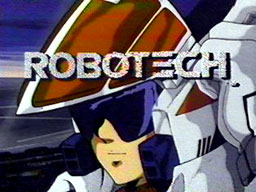
Babylon 5 is an American space opera television series created by writer and producer J. Michael Straczynski, under the Babylonian Productions label, in association with Straczynski's Synthetic Worlds Ltd. and Warner Bros. Domestic Television. After the successful airing of a test pilot movie on February 22, 1993, Babylon 5: The Gathering, Warner Bros. commissioned the series for production in May 1993 as part of its Prime Time Entertainment Network (PTEN). The show premiered in the US on January 26, 1994, and ran for five 22-episode seasons.

Robotech is a science fiction franchise that began with an 85-episode anime television series produced by Harmony Gold USA in association with Tatsunoko Production and first released in the United States in 1985.

Science fiction first appeared in television programming in the late 1930s, during what is called the Golden Age of Science Fiction. Special effects and other production techniques allow creators to present a living visual image of an imaginary world not limited by the constraints of reality.

Special effects are illusions or visual tricks used in the theatre, film, television, video game, amusement park and simulator industries to simulate the imagined events in a story or virtual world.
Visual effects is the process by which imagery is created or manipulated outside the context of a live-action shot in filmmaking and video production. The integration of live-action footage and other live-action footage or CGI elements to create realistic imagery is called VFX.

Digital Domain is an American visual effects and digital production company based in Playa Vista, Los Angeles, California. The company is known for creating digital imagery for feature films, advertising and games from its locations in California and Vancouver, British Columbia, Canada, including its own virtual production studio.

Liberty Media Corporation is an American mass media company controlled by chairman John C. Malone. The company has three divisions, reflecting the company's ownership stakes in Formula One, SiriusXM, and the Atlanta Braves Major League Baseball team.
"The Parliament of Dreams" is the fifth episode of the first season of the multi-award winning science fiction television series, Babylon 5. The Babylon 5 makeup team won an Emmy Award for the special alien makeup design for this episode.
Mainframe Studios is a Canadian computer animation company owned by Wow Unlimited Media and based in Vancouver, British Columbia. Founded in 1993 as Mainframe Entertainment Inc. by Christopher Brough, Ian Pearson, Phil Mitchell, Gavin Blair and John Grace, the company established itself as a leading contributor to the introduction of computer-generated imagery (CGI) in animation, film and television.

Harmony Gold USA, Inc. is an American film and television production company. It was founded in 1983 by Egyptian-born Frank Agrama and is managed by his daughter, Jehan F. Agrama.

ImageMovers (IM), known as South Side Amusement Company until 1997, is an American production company which produces CGI animation, motion-capture, live-action films and television shows. The company is known for producing such films as Cast Away (2000), What Lies Beneath (2000), The Polar Express (2004), Monster House (2006), and Beowulf (2007). From 2007 to 2011, The Walt Disney Company and ImageMovers founded a joint venture animation facility known as ImageMovers Digital which produced two motion-captured CGI-animated films: A Christmas Carol (2009) and Mars Needs Moms (2011) for Walt Disney Pictures, neither of which were financially successful.

Robotech 3000 was Harmony Gold's attempt to revive the Robotech franchise before the turn of the millennium. After the relative success of Voltron: The Third Dimension and Roughnecks: Starship Troopers Chronicles, a new Robotech sequel was proposed that would use 3D CG visuals, with producer Jason Netter and writer Carl Macek at the helm.

Robotech is an American 85-episode adaptation of three unrelated Japanese anime television series made between 1982–1984 in Japan; the adaptation was aired in 1985. Within the combined and edited story, Robotechnology refers to the scientific advances discovered in an alien starship that crashed on a South Pacific island. With this technology, Earth developed giant robotic machines or mecha to fight three successive extraterrestrial invasions.
Douglas Netter was a United States television industry executive, his credits largely being in the field of science fiction. He was first credited as associate producer of the 1967 Matt Helm movie The Ambushers which involved a US-government built flying saucer.
Foundation Imaging was a CGI visual effects studio, computer animation studio, and post-production editing facility.

Doug Drexler is a visual effects artist, designer, sculptor, illustrator, and a makeup artist who has collaborated with such talents as Al Pacino, Dustin Hoffman, James Caan, Meryl Streep, and Warren Beatty. He began his career in the entertainment industry working for makeup artist Dick Smith on such films as The Hunger and Starman. He has also contributed to Three Men and a Little Lady, The Cotton Club, FX, Manhunter and Dick Tracy. Dick Tracy earned Drexler an Oscar, as well as The British Academy Award and the Saturn Award for his special makeup effects on characters such as Big Boy Caprice and Mumbles. Two Emmy nominations in the same field followed for three years working on Star Trek: The Next Generation, where he performed such tasks as aging Captain Picard for "The Inner Light". His final make-up job for the series was the Mark Twain makeup worn by Jerry Hardin in the two part episode "Times Arrow"
The history of computer animation began as early as the 1940s and 1950s, when people began to experiment with computer graphics – most notably by John Whitney. It was only by the early 1960s when digital computers had become widely established, that new avenues for innovative computer graphics blossomed. Initially, uses were mainly for scientific, engineering and other research purposes, but artistic experimentation began to make its appearance by the mid-1960s – most notably by Dr Thomas Calvert. By the mid-1970s, many such efforts were beginning to enter into public media. Much computer graphics at this time involved 2-dimensional imagery, though increasingly as computer power improved, efforts to achieve 3-dimensional realism became the emphasis. By the late 1980s, photo-realistic 3D was beginning to appear in film movies, and by mid-1990s had developed to the point where 3D animation could be used for entire feature film production.

Computer-generated imagery (CGI) is the use of computer graphics to create or contribute to images in art, printed media, video games, simulators, computer animation and VFX in films, television programs, shorts, commercials, and videos. The images may be dynamic or static, and may be two-dimensional (2D), although the term "CGI" is most commonly used to refer to the 3-D computer graphics used for creating characters, scenes and special effects in films and television, which is described as "CGI animation".

Cinesite Vancouver is a Canadian animation company founded by husband and wife duo Greg Tiernan and Nicole Stinn. The company was founded in October 2003, in Vancouver, British Columbia.
Ron Thornton (1957–2016) was a pioneer in the field of computer-generated visual effects for film and television. He is best known for pioneering the use of Computer Generated Imagery (CGI) in the industry, through his work on the Babylon 5 series, which was the first television series to use CGI for all its visual effects. Thornton and his team won an Emmy award in 1993 for their work in the field. During his career, Thornton also worked with teams providing visual effects for many major science fiction productions, including Doctor Who, Blake's 7, Star Trek, and Buffy the Vampire Slayer.











